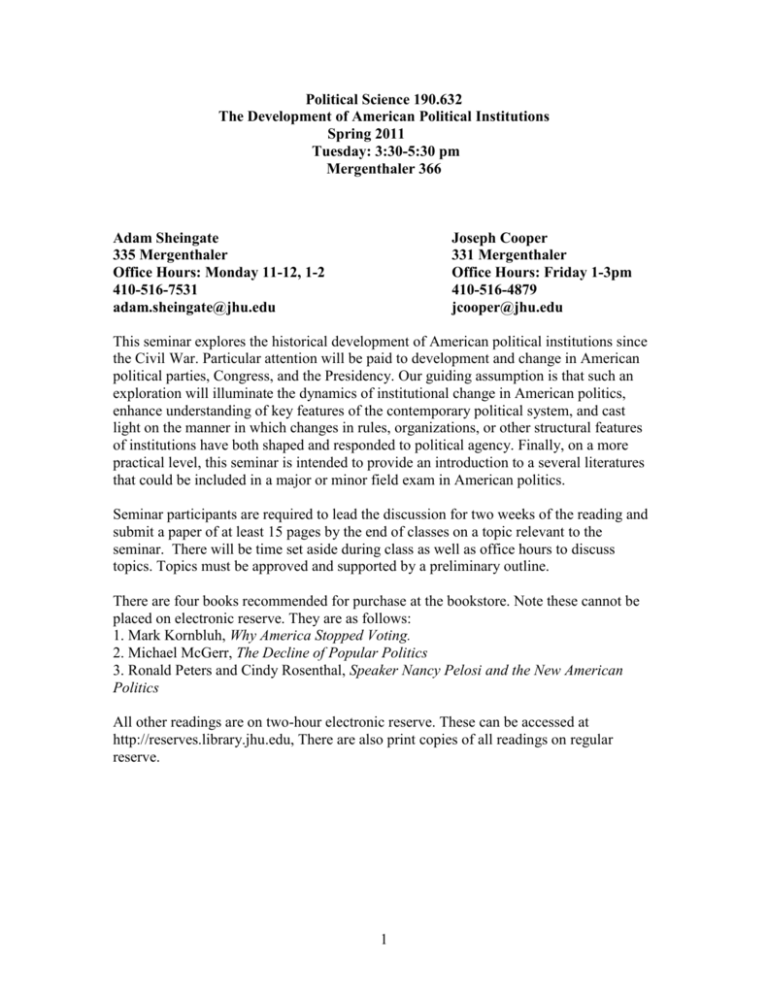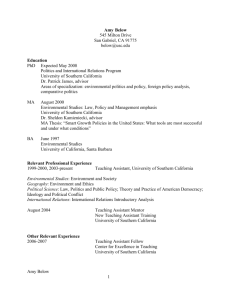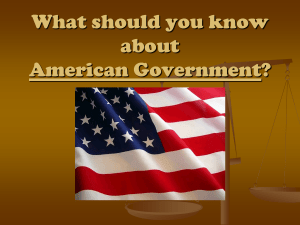Political Science 190.632
advertisement

Political Science 190.632 The Development of American Political Institutions Spring 2011 Tuesday: 3:30-5:30 pm Mergenthaler 366 Adam Sheingate 335 Mergenthaler Office Hours: Monday 11-12, 1-2 410-516-7531 adam.sheingate@jhu.edu Joseph Cooper 331 Mergenthaler Office Hours: Friday 1-3pm 410-516-4879 jcooper@jhu.edu This seminar explores the historical development of American political institutions since the Civil War. Particular attention will be paid to development and change in American political parties, Congress, and the Presidency. Our guiding assumption is that such an exploration will illuminate the dynamics of institutional change in American politics, enhance understanding of key features of the contemporary political system, and cast light on the manner in which changes in rules, organizations, or other structural features of institutions have both shaped and responded to political agency. Finally, on a more practical level, this seminar is intended to provide an introduction to a several literatures that could be included in a major or minor field exam in American politics. Seminar participants are required to lead the discussion for two weeks of the reading and submit a paper of at least 15 pages by the end of classes on a topic relevant to the seminar. There will be time set aside during class as well as office hours to discuss topics. Topics must be approved and supported by a preliminary outline. There are four books recommended for purchase at the bookstore. Note these cannot be placed on electronic reserve. They are as follows: 1. Mark Kornbluh, Why America Stopped Voting. 2. Michael McGerr, The Decline of Popular Politics 3. Ronald Peters and Cindy Rosenthal, Speaker Nancy Pelosi and the New American Politics All other readings are on two-hour electronic reserve. These can be accessed at http://reserves.library.jhu.edu, There are also print copies of all readings on regular reserve. 1 Part One: The Late Nineteenth-Century I. Party Structures and Processes A. The Traditional Party System: Defining Features (Feb. 8) 1. Mark Kornbluh, Why America Stopped Voting, pp. 11-88. 2. Richard Bensel, The American Ballot Box, Law, Identity, and the Polling Place in the Mid-19th Century, Studies in American Political Development, Vol. 17, pp. 127, Spring, 2003. 3. Daniel Klinghard, Nationalization of American Party Organization, pp. 25- 66 4. Ronald Johnson and Gary Libecap, Federal Service System, pp. 12-48 B. The Traditional Party System: Party Organization and Decline (Feb. 15) 1. Mark Kornbluh, Why America Stopped Voting, pp. 89-161 2. Harold Gosnell, “Thomas C. Platt—Political Manager”, Political Science Quarterly 38:443-469 (September, 1923). 3. Michael McGerr, Decline of Popular Politics, pp. 69-107. 4. Klinghard, pp. 98-144. II. Legislative Structure, Process, and Politics A. House Structure and Politics (Feb.22) 1. Eric Schickler, Development of the Committee System, in Schickler and Lee, eds., Oxford Handbook on Congress (Chapter 31). 2. Randal Strahan, Thomas Reed and the Rise of Party Government, in Roger Davidson, Masters of House, pp. 33-62. 3. Jason Roberts and Steve Smith, “The Evolution of Agenda-Setting Institutions in the House and Senate, In David Brady and Mathew McCubbins, eds., Party, Process, and Political Change in Congress, Vol.2, pp.182-204 (chapter 13). 4. Joseph Cooper and David Brady, “Institutional Context and Leadership Style: The 2 House From Cannon to Rayburn”, American Political Science Review, Vol. 75, pp 411-425 (June, 1981). 5. Adam Sheingate, Rethinking Rules: Complexity and Creativity in the House of Representatives, In James Mahoney and Kathleen Thelen,eds. Explaining Institutional Change, pp. 168-203. B. Senate Structure and Politics (March 1) 1. Joseph Cooper, “Analyzing Institutional Change: Bill Introduction in the 19th Century Senate”, in Bruce Oppenheimer, ed., U.S. Senate Exceptionalism, pp. 182-211. 2. Gerald Gamm and Steven Smith, “Emergence of Senate Party Leadership” in Oppenheimer, ed., U.S. Senate Exceptionalism, pp. 212-238. 3. Lewis Gould, The Most Exclusive Club, pp. 17-92. 4. Gregory Wawro and Eric Schickler, “Where’s the Pivot? Obstruction and Law Making in the Pre- Cloture Senate”, American Journal of Political Science, Vol. 48, pp.758-774 (October, 2004). 5. David Brady and David Epstein, "Intraparty Preferences, Heterogeneity, and the Origins of the Modern Senate: Progressive Reformers in the House and Senate, 1890-1920”, Journal of Law, Economics, and Organization, Vol 13, pp.26-50 (April, 1997). III. Presidential Leadership A. President, Party, and Congress (March 8) 1. Michael McGerr, Decline of Popular Politics, pp. 138-184 2. Klinghard, pp. 144-235 3. James Ceaser, Presidential Selection: Theory and Development, pp. 170-212. 4. Adam Sheingate, “Publicity and the Progressive-Era Origins of Modern Politics,” Critical Review, Vol. 19, pp. 461-480 (April 2007) B. President and Bureaucracy (March 15) 1. Stephen Skowronek, Building A New American State, pp. 163-211 and 248-293. 3 2. Daniel Carpenter, “State Building Trough Reputation Building:Coalitions of Esteem and Program Innovation in the National Postal System, 1883-1913”, Studies in American Political Development, Vol.14, pp.121-155 (Fall, 2000). 3. Samuel Kernell and Michael MacDonald, “Congress and America’s Political Development: The Transformation of the Post Office From Patronage to Service, American Journal of Political Science, Vol. 43, pp. 792-811 (July, 1999) 4. Johnson and Liebcap, pp. 48-76. Part Two: The Modern Political System I. The Modern Party System A. The Emergence of the Modern Party System (March 29) 1. David Mayhew, Placing Parties in American Politics, pp. 308-333 2. Jeane Kirkpatrick, “Changing Patterns of Electoral Competition,” in Anthony King, ed., The New American Political System, pp. 249-287. 3. John Aldrich, Why Parties, pp. 241-296 4. Sean Theriault, Polarization in Congress, pp.11-58. 5. Nicol Rae, “Be Careful What You Wish For,” Annual Review of Political Science, Vol. 10, pp. 169-191 (2007). B. The Modern Party System (April 5) 1. Gary Jacobsen, “Barack Obama and the American Public”,2010 APSA Paper, pp. 1-29. 2. Magleby, in Obama: Year One, pp. 31-55. 3. Paul Herrnson, “The Roles of Party Organizations, Party-Connected Committees, and Party Allies in Elections,” Journal of Politics, Vol. 71 (2009): 1207-1224. 4. Barry Burden and Gerald Pomper Chapters in Nelson, ed., The Election of 2008, pp. 22-74 (chapters 2-3) 5. Ronald Peters and Cindy Rosenthal, Speaker Nancy Pelosi and the New American Politics, pp. 110-155 (Chapter 4). 4 II. The Modern Congress A. The Emergence of the Modern House (April 12) 1. Nelson Polsby, How Congress Evolves, pp. 7-109 2. Peters and Rosenthal, Speaker Nancy Pelosi, pp. 63-19 and 155-193 (Chapters 3 and 5) 3. Randal Strahan, “Party Leadership”, in Schickler and Lee, eds., Oxford Handbook on Congress (Chapter 17). B. The Emergence of the Modern Senate (April 19) 1. Barbara Sinclair, The Transformation of the Senate, pp. 8-101. 2. Fred Harris, Deadlock or Decision: The US Senate and the Rise of National Politics, pp. 159-188. 3. Gregory Wawro and Eric Schickler, “Legislative Obstructionism,” Annual Review of Political Science, pp. 297-319 (2010)??? 4. Barbara Sinclair, “The New World of U.S. Senators,” in Dodd and Oppenheimer, Congress Reconsidered, pp. 1-22. 5. Vincent Moscardelli, “Harry Reid and Health Care Reform in the Senate,” The Forum, Volume 8, Issue1, Article 2 (2010). III. Presidential Leadership A. President, Party, and Congress (April 26) 1. Stephen Skowronek, “The Politics of Leadership at the End of the Twentieth Century,” in Presidential Leadership in Political Time, chapter 3 (pp. 79-116). 2. Joseph Cooper, “From Congressional to Presidential Predominance”, in Dodd and Oppenheimer, Congress Reconsidered, pp.361-393. 3. George C. Edwards, III, “Impediments to Presidential Leadership: the Limitations of the Permanent Campaign and Going Public Strategies,” in Presidential Leadership, pp. 145-170. 5 4. Sidney Milkis and Jesse Rhodes, 2010 APSA Paper on “Barack Obama, The Democratic Party and the Evolution of the American Party System”. 5. Frances Lee, Beyond Ideology: Politics, Principle, and Partisanship in the U.S. Senate, pp. 74-102 (chapter 4). B. President and Bureaucracy (May 3) 1. Terry Moe, “The Politicized Presidency”, in John Chubb and Paul Peterson, eds., The New Directions in American Politics, pp. 235-271. 2. Mathew Dickinson, “The Executive Office of the President,” in Aberbach and Peterson, The Executive Branch, pp. 135-174 (chapter 5) 3. David Lewis, “ Modern Presidents and the Transformation of the Federal Personnel System”, The Forum, Vol. 7, Issue 4, article 6. 4. Kenneth Mayer, “ Executive Orders” and Richard Pious, “Military Tribunals, Preogative Power, and the War on Terrorism” Joseph Bessette and Jeffrey Tulis, eds., The Constitutional Presidency, pp.123-173. 5. Richard Pious, “Military Tribunals, Prerogative Power, and the War on Terrorism,” in in Joseph Bessette and Jeffrey Tulis, eds., The Constitutional Presidency, pp. 123-148. 6. Bert Rockman and Richard Waterman, “Two Normative Models of Presidential Leadership,” in Bert Rockman and Richard Waterman, Presidential Leadership: The Vortex of Power, pp. 331-347. 6









